Black mamba – kiss of death
Black mamba (Dendroaspis polylepis) – the largest venomous snake in Africa
The second longest venomous snake in the world
The longest venomous snake of Africa, being also one of the fastest and most aggressive crawling reptiles. It evokes many emotions – African tribes from generation to generation pass many superstitions reinforcing the aura of fear and hate associated with the black mamba.
Classification
- Class: Reptilia
- Order: Squamata
- Suborder: Serpentes
- Family: Elapidae
- Subfamily: Elapinae
- Genus: Dendroaspis
- Species: D. polylepis
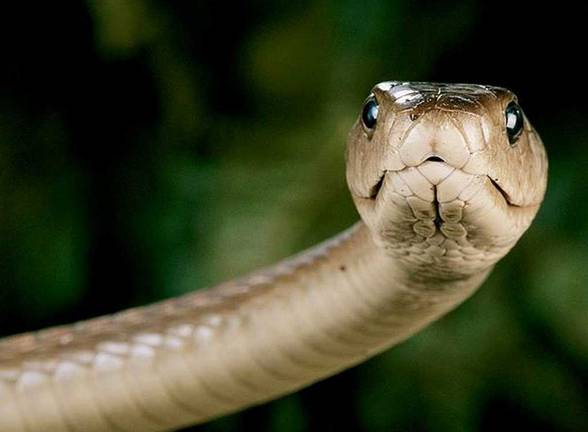
Name
It is named after the color of the inside of its mouth – hence the black mamba.
Areas of occurrence
With all certainty black mamba inhabits the South-West Africa, yet it is hard to establish whether it also lives in Central and East Africa – there are some rumors about its presence there but they have not been confirmed.
This snake can adapt to many ground types. It lives in the savanna, thick rainforests, croplands, rocky slopes, swamps, bush formations and meadows. It prefers a dry environment e.g. aggregations of desert bushes. It often uses termite mounds and hollow tree trunks as shelter.
The interior of a termite mound is a perfect way to deal with excessive heat, as it acts like a natural air conditioning system thanks to a complex network of holes, tunnels and shafts allowing natural air circulation.
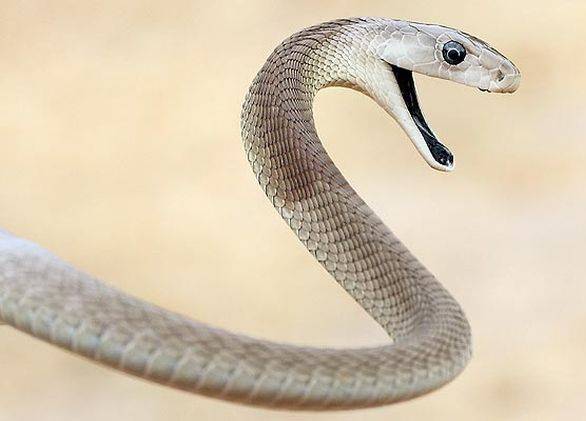
Characteristic
Appearance
An adult snake has an olive, grey, brownish, sandy or dark coloration. Younger mambas are brighter-colored, yet not as much to be mistaken with another species – the eastern green mamba (Dendroaspis angusticeps). Its ventral area is normally cream-colored, sometimes greenish or yellowish. The posterior body parts is often spotted with dark specks, scales are sometimes alternately bright and dark.
The inside of its mouth is dark blue or ink black. Its head is large, narrow and slightly elongated. Fangs grow out of the front of its upper jaw. Eyes are usually black or dark brown with a yellow or silver-white pupil.
The snake’s skin darkens with age. There is practically no sexual dimorphism among this species. It is the Africa’s longest venomous snake, ranked second in the world, right behind the king cobra (Ophiophagus hannah).
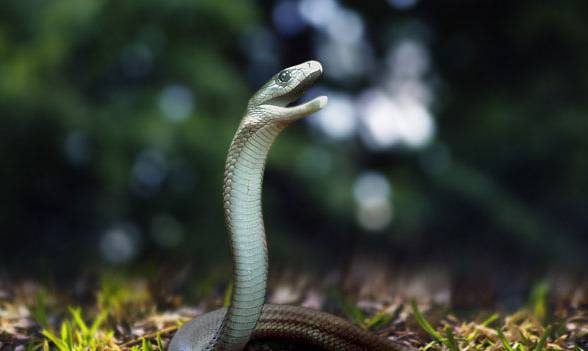
Hunting and dietary habits
A hunting mamba crawls with its head lifted above ground, moving very fast in search for food. When its prey is sighted, mamba ‘freezes’ for a brief moment before striking with several rapid bites, killing the animal. If a victim tries to escape, mamba repeats its series of ‘venom strikes’.
Its prey mostly consists of: mammals (especially hyraxes, mice, rats, shrews, bats, squirrels and galagos). It also eats birds, especially chicks and other snakes e.g. puff adders (Bitis arietans) and cape cobras (Naja nivea). Hunts for larger ungulate mammals also proved effective – e.g. for the blue duiker (Philantomba monticola / Cephalophus monticola).
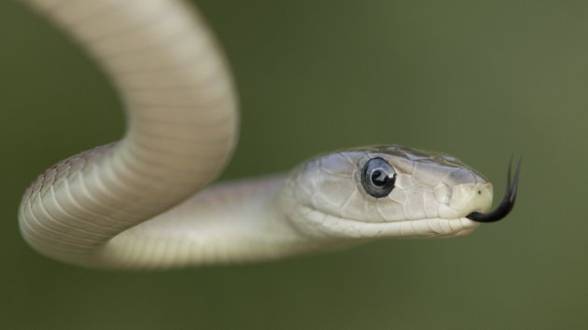
Senses
As most snakes, mamba also uses its sight to detect motion. The moment its potential victim makes a sudden, rapid movement, it is immediately attacked by the snake. Mamba collects the particles of the surrounding air with its tongue, which are subsequently passed to the vomeronasal organ (Jacobson’s organ), serving as a chemoreceptor.
It does not have ears, but it senses the ground vibrations perfectly. When it feels threatened, it does not attack right away, but it gives clear signals that it is preparing the defensive.
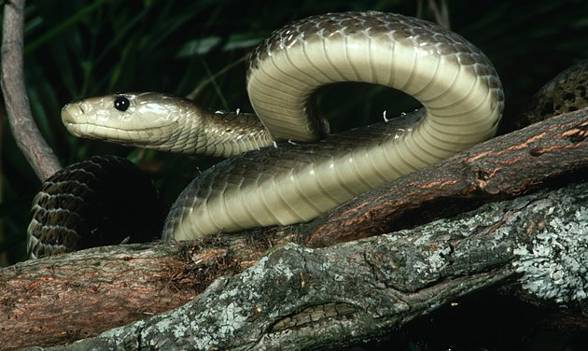
Lifestyle
Its Latin name suggests that mamba lives mostly on trees, but it is a false connection. It leads a terrestrial, diurnal lifestyle. It has an exceptionally high movement speed and a distinctive crawling technique – it moves with front section lifted when trying to cover larger distances. Black mamba is considered the fastest terrestrial snake in the world.
An abandoned termite mound, a rocky cleft or a hollow tree trunk often becomes mamba’s house (it acts highly territorially). When somebody/something enters its territory, it becomes very aggressive, but usually it is withdrawn and flees from other animals or humans, avoiding confrontation.
When a territorial, maternal or food-related defense is the case, mamba switches its attitude completely. Pushed into a corner, black mamba acts like a cobra – raises 1/3 of its body, hisses, spreads its neck presenting the hood and opens its mouth, revealing its terrifying black coloration. If an intruder is reluctant to back away, mamba does not hesitate to strike several times.
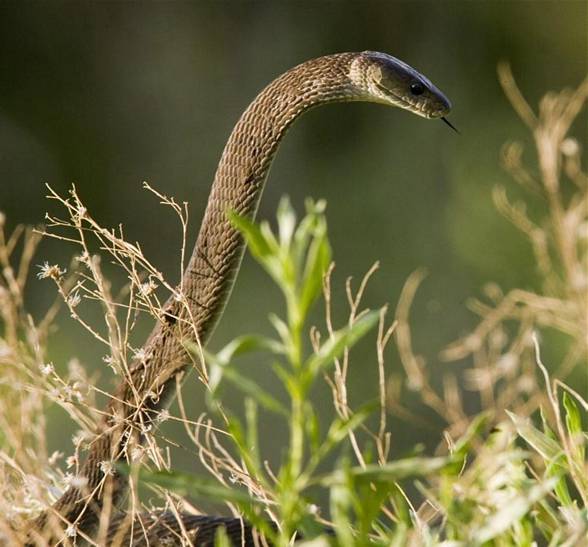
Breeding
Black mamba breeds only once a year, beginning its laying season in spring (October). During this period males fight over females. Two snakes do a ‘stand-off’, trying to bash the opponent’s head down to the ground. Such a duel usually lasts a few minutes, though sometimes it may endure over an hour. The aim of those fights is to gain right to copulate with fertile females. Only in the mating season do males and females share any kind of relationship with each other, leading a solitary lifestyle through the rest of the year, culturally ignoring one another. A female leaves an olfactory track which is pursued by a male.
During copulation a male inserts a so called hemipenis into the female’s genital tract. After fertilization, eggs develop in the mother’s body for about 60 days. During this period it searches for the most convenient place for a nest. An abandoned termite mound is usually a perfect spot. Black mamba lays from 15 to 25 eggs in one brood. During incubation, which lasts for the next 60 days it becomes exceedingly aggressive.
The baby snakes are about 50 cm long and are completely independent after hatching. They have venom from the very beginning of their lives, yet as much as an adult snake.
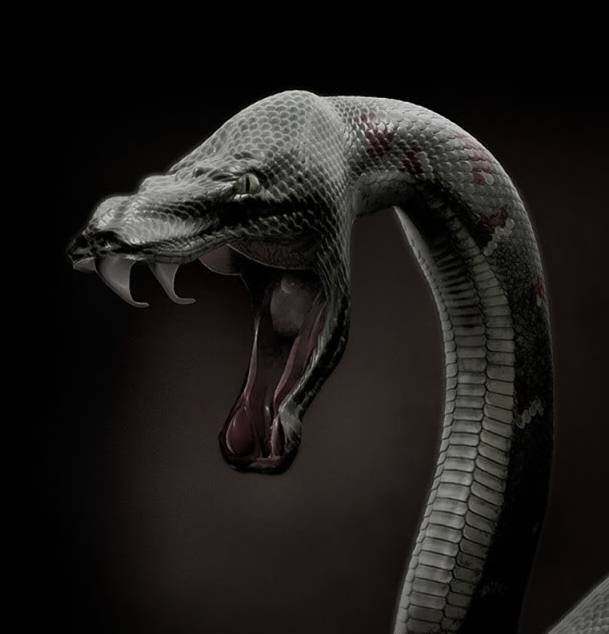
‘Kiss of death’ – a black mamba’s bite
Venom toxicity depends on the inhabited area. Those differences might prove substantial – snake from one region may have a completely different level of venom toxicity from the ‘neighboring’ snakes. However one thing we know for certain – black mamba’s venom is the quickest-working toxin in the world. There is no immune species, for it contains very powerful neurotoxins (toxins that affect the nervous system).
A single black mamba’s bite injects 50 – 120 mg of venom into the organism, whilst only 10-15 mg is enough to kill an adult human. The highest recorded portion of venom in a single bite is 400 mg.
A black mamba’s bite is often called a ‘kiss of death’ as before creating an antitoxin the mortality rate of mamba’s attacks was straight 100%
Every black mamba’s bite is a severe case requiring administering large portions of serum (10-12 phials) almost immediately after a bite. Venom kills in about 30 minutes, but sometimes the organism struggles for 2-3 hours.
The length of period between a bite and death is influenced by many factors e.g. the bitten person’s health condition (and snake’s condition as well), bite location or the depth of the wound. Death is a result of breathing muscles paralysis. Therefore, despite the existence of serums, almost every case of black mamba’s attack is fatal, for besides the venom black mamba is exceptionally fast and aggressive.
However one fact is worth mentioning – mamba’s attacks on humans are extremely seldom, for these snakes rather avoid confrontation with us (they do not inhabit densely populated areas), which is rare among African venomous snakes.
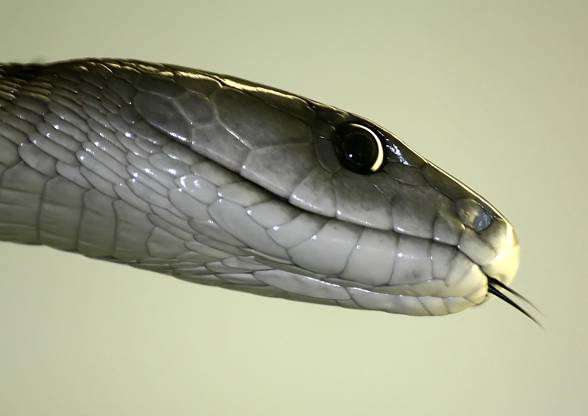
Black mamba – world’s most aggressive snake
Many specialists call black mamba the most aggressive snake in the world, which tends to attack without an adequate reason. Such incidents most likely take place only in the breeding season or during territorial defense.
Black mamba – the world’s fastest snake
A black mamba’s normal ‘cruising speed’ is 11 – 19 km/h (7 – 12 mph), yet it can accelerate to 16 – 20 km/h on shorter distances. The fastest recorded snake was crawling with a velocity of 23 km/h.
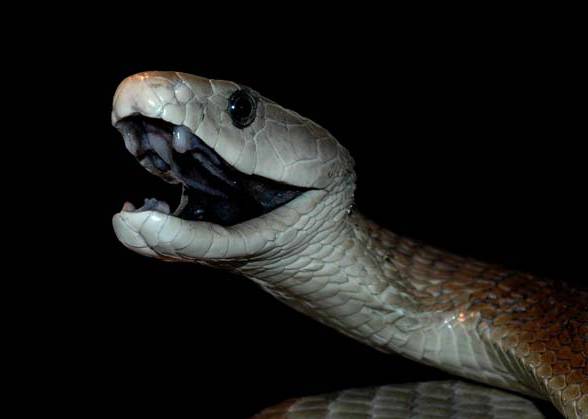
Detailed characteristic / size
Black mamba (Dendroaspis polylepis)
- Length: 2 – 3 m (6ft 7in – 9ft 10in) on average – they often measure from 3.1 to 3.75 m (10ft 2in – 12ft 4in), rarely reach 4.3 – 4.5 m (14ft 1in – 14ft 9in), the longest recorded black mamba from Zimbabwe had 4.48 meters (14ft 8in) of length.
- Body mass: 1.6-3.1 kg (3 – 6 lb)
- Lifespan: up to 14 years in captivity, they can live longer in the wild.
- Speed: up to 23 km/h (14 mph) – it’s the fastest snake in the world

Black mamba – interesting facts
- Black mamba always returns to the same dens and territories.
- Strong stomach acid digests prey in 8-10 hours.
- Black mamba’s venom contains proteins, which act like a painkiller for mice, comparable to morphine in terms of strength, yet without most of its side effects.
- First toxin effects among bitten humans appear about 5 minutes after attack.
- Black mamba’s natural enemies are mongooses and birds of prey. Immature mambas are often victims of the Cape file snake (Mehelya capensis)
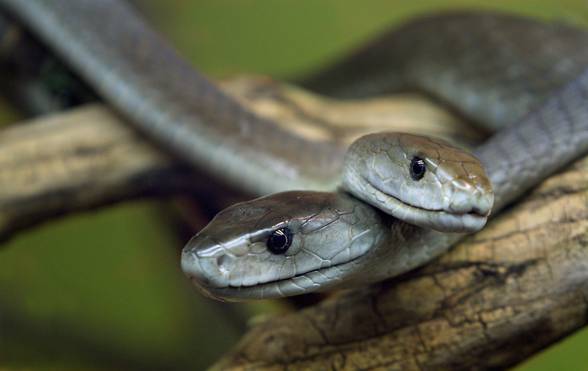




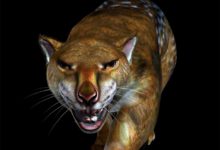
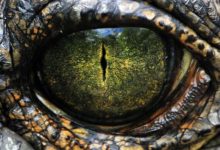

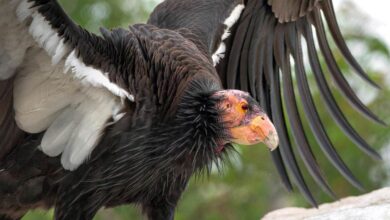
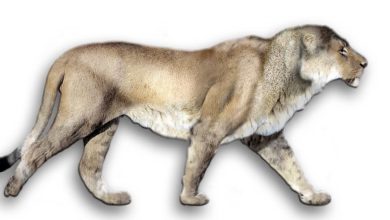
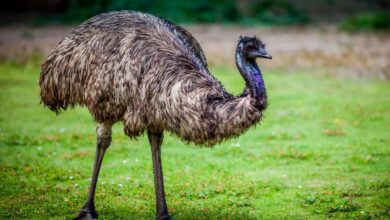

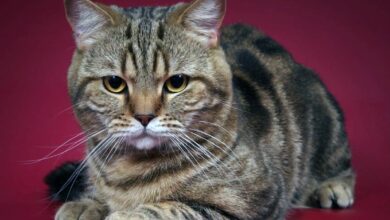


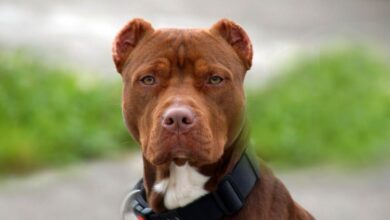

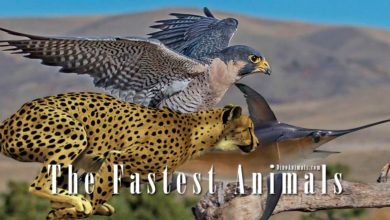


Mr. Johan Marais (the author of several books about snakes) sent us a handful of comments regarding the article about the black mamba. Because several theses contained in the article are different from the remarks of Mr. Marais, we decided to publish his whole comment, so that readers have a complete picture of the black mamba. More about: Johan Marais. We thank you for your valuable comments.
Remarks:
‘One of the fastest and most aggressive crawling reptiles’
Absolutely not true. The Black Mamba is a shy and elusive snake that avoids people at all cost. If cornered or provoked (captured by the tail) it will not hesitate to strike and may bite more than once, but in the field it is very quick to escape. If you are 5 m or more away from a Black Mamba you are perfectly safe and will not be attacked or bitten. If we look at Black Mamba bites in South Africa, about a dozen bites are reported annually and of the 10 – 12 snakebite fatalities yearly about half of them are from Black Mamba bites.
‘With all certainty Black Mamba inhabits the South-West Africa, yet it is hard to establish whether it also lives in Central Africa and East Africa – there are some rumours about its presence there but they have not been confirmed.’
The distribution of the Black Mamba is fairly well known and distribution maps have been published in a number of popular books including Dangerous Snakes of Africa (Spawls and Branch), A Field Guide to the Reptiles of East Africa (Spawls et al), Guide des Serpents d’Afrique Occidentale (Trape and Mane) and Venomous Snakes of Africa (Dobiey and Vogel), to mention but a few. It occurs from the extreme Eastern Cape into KZN and further north into Mozambique, Zimbabwe, Botswana, Namibia, Angola, Malawi, Zambia, Angola, the DRC, Tanzania, Burundi, Rwanda, Kenya, Uganda, South Sudan, Somalia, Ethiopia, Eritrea, C.A.R., Cameroon, Burkina Faso, Guinea, Senegal and elsewhere.
‘It lives in the savanna, thick rain forests, croplands, rocky slopes, swamps, bush formations and meadows. It prefers a dry environment…’
No the Black Mamba does not live in thick rainforests and swamps. As is said in the second sentence.
‘Younger mambas are bright-coloured, yet not as much to be mistaken with another species – the Western Green Mamba (Dendroaspis angusticeps).’
A juvenile Black Mamba is not brightly coloured but grey with a lighter belly. The Western Green Mamba is Dendroaspis viridis, not Dendroaspis angusticeps.
‘The hunting mamba crawls with its head lifted above the ground, moving very fast in search of food.’
The Black Mamba does often lift its head when covering distance but not when hunting. And it does not move very fast when hunting, unless engaged in a brief chase after prey.
‘Eats snakes e.g. puff adders (Bitis arietans) and cape cobras (Naja nivea)’
It may well eat Cape Cobras but their range barely overlaps in southern Namibia and I am not aware of any evidence that the Black Mamba eats Cape Cobras.
‘When it feels threatened, it does not attack right away, but it gives clear signals that it is preparing the defensive.’
A nonsensical sentence and I have no idea what is meant.
‘Black Mamba is considered the fastest terrestrial snake in the world.’
While I concede that it is fast-moving, it doesn’t compare with the speed of a large Olive Grass Snake (Psammophis mossambicus) or Western Yellow-bellied Sand Snake (Psammophis subtaeniatus). I do not have sufficient experience to compare the speed of the Black Mamba with snakes on other continents. While snakes appear to move very quickly, the maximum velocities measured in swiftly crawling snakes such as racers and mambas are around 12 – 13 km/h and less in species like garter snakes (How snakes work by Harvey B. Lillywhite).
‘An abandoned termite mound, a rocky cleft or hollow tree trunk often becomes mamba’s house (it acts highly territorially). When somebody/something enters the territory, it becomes very aggressive..’
This is a popular fallacy and is not true.
‘Only in the mating season do males and females share any kind of relationship with each other, leading a solitary lifestyle through the rest of the year, culturally ignoring one another.’
While this is largely true I know of several pairs of Black Mambas that share the same hole throughout the year and will bask together daily.
‘Black mamba lays from 15 – 25 eggs.’
Not true, they lay 6 – 17 eggs per clutch.
‘Hatchlings have venom from the very beginning of their lives, yet as much as an adult.’
Probably a typo as a juvenile Black Mamba has a fraction of the venom yield of an adult.
‘Venom toxicity depends on inhabited area. Those differences might prove substantial – snake from one region may have a completely different level of venom toxicity from the ‘neighboring’ snakes.’
There is only one species of Black Mamba (Dendroaspis polylepis) and no subspecies. While the venom of the Black Mamba may vary somewhat from area to area, there is no evidence of substantial differences.
‘A single black mamba’s bite injects 50 – 120 mg of venom into the organism, whilst only 10 -15 mg is enough to kill an adult human. The highest recorded portion of venom in a single bite is 400 mg.’
I think the author got confused between highest portion of venom injected and the maximum venom yield for the Black Mamba which is 400 mg.
‘Every black mamba’s bite is a severe case requiring administering large portions of serum (10 – 12 phials) almost immediately after a bite. Venom kills in about 30 minutes, but sometimes the organism struggles for 2 – 3 hours.’
Again a number of inaccuracies. Many Black Mamba victims have survived without receiving antivenom – it obviously depends on the amount of venom injected and that varies. 10 – 12 vials of polyvalent antivenom is a normal initial dose for virtually any serious snakebite in South Africa, be it a Puff Adder, Mozambique Spitting Cobra, Cape Cobra etc. In one very serious Black Mamba bite in KZN last year the patient received 40 vials of polyvalent antivenom and recovered fully. For a Black Mamba bite victim to die in 30 minutes, while possible, is exceptional and it will usually take a few hours.
‘Therefore, despite the existence of serums, almost every case of black mamba’s attack is fatal, for besides the venom black mamba is exceptionally fast and aggressive.’
Not true, many Black Mamba victims that are hospitalised soon after a bite are treated successfully and I have met more than a dozen people who have survived Black Mamba bites, some more than one. Mention is again made of their speed and aggression, which is just not true.
‘Many specialists call black mamba the most aggressive snake in the world, which tends to attack without adequate reason. Such incidents most likely take place only in the breeding season or during territorial defense.’
Absolute rubbish and there is no evidence that the Black Mamba is more aggressive in the breeding season. And there is no such thing as territorial defence.
‘The Black Mamba’s normal ‘cruising speed’ is 11 – 19 km/h, yet it can accelerate 16 – 20 km/h on shorter distances. The fastest recorded snake was crawling with a velocity of 23 km/h.’
Again not true and information probably found in a Google search. The maximum speed of any snake that was measured is 13 km/h (How snakes work by Harvey B. Lillywhite, Oxford University Press).
‘Longest recorded Black Mamba from Zimbabwe measured 4.48 m.’
Not true – it is actually a female from Figtree, Matobo that measured 3.2 m (The Snakes of Zimbabwe and Botswana by Broadley and Blaylock).